Notes For All Chapters Geography Class 9 CBSE
The term climate is the sum total of.the weather conditions (including variations) over a large area for a long period of time (more than thirty years).
The term weather refers to the state of the atmosphere at a place and time with reference to the following elements
- Temperature Humidity
- Air pressure
- Cloudiness or sunshine
- Precipitation (Rainfall or snowfall)
- Wind
The weather conditions fluctuate very often within a day. Based on the generalised fhonthly atmospheric conditions, the year is divided into seasons such as winter, summer and rainy seasons. The world is divided into a number of climatic regions. In Asia, India and other South and South-Eastern countries have monsoon type of climate.
The word monsoon is derived from the Arabic word ‘mausim’ which literally means season. ‘Monsoon’ refers to the seasonal reversal in the wind direction during a year.
Regional Climatic Variation In India
Although there is an overall unity in the general climatic pattern in India, there are some perceptible regional variations.
Temperature
The temperature in the winter in North-Western mountainous regions can go down to – 45° C (at Drass in Jammu and Kashmir), while it is 22°C in Thiruvananthapuram in Kerala. Similarly, it can go up to 50°C in summer in some parts of Western Rajasthan and 20°C in Shillong.
In many areas, there is a wide variation between day and night temperatures. In the Thar Desert, the day temperature may rise up to 50°C and drop down to near 15°C the same night. On the other hand, there is hardly any difference in day and night temperatures in the Andaman and Nicobar islands or in Kerala.
Precipitation
There is a wide variation observed in its amount and seasonal distribution. Precipitation in the form of snowfall occurs only in upper parts of Himalayas, the rest of the country receives rainfall.
A typical example, the annual precipitation varies from over 400 cm in Meghalaya to less than 10 cm in Ladakh and Western Rajasthan. Similarly, most parts of the country receive rainfall from June to September, but the Tamil Nadu coast gets most of its rain during October and November.
Coastal regions experience different weather conditions from the interior regions. For example, temperature and seasonal contrast are relatively mild. The rainfall also decreases from East to West. Such differences help to create a variety in lives of people— the food they eat, the clothes they wear, the kind of houses they used for living and so on.
Climatic Controls
Permanent factors which govern the general nature of the climate of any location on the earth are called factors of Climatic Controls.
The factors of climatic controls are m Latitude The angular distance of a location from the equator in North-South direction is called latitude. Due to the curvature of the earth, latitude changes the amount of solar energy received. As a result, air temperature decreases from the equator towards the poles.
Altitude It refers to the height above mean sea level. With increase of height from the earth surface, the temperature decreases and air becomes less dense. Therefore, hilly regions are cooler in summer.
Pressure and Wind System It depends on the latitude and altitude of a place. Thus, it influences the temperature and rainfall pattern of the area.
Continentality or Distance from the Sea The sea exerts a moderating influence on the climate. As the distance from the sea increases, the weather conditions become more extreme (high temperature and rainfall variation between seasons). .
Ocean Currents Along with onshore winds, the ocean currents (warm or cold) affect the climate of coastal areas. For example, cold onshore currents bring coolness in coastal areas.
Relief Features High mountains stop cold or hot winds from reaching a location..It can also cause rain or snow if the place is on the windward side of the mountains. The leeward side of the mountains are.
Factors Affecting India’s Climatic
Latitude
The Tropic of Cancer (23°3 CV N) divides the country into the tropical zone (South of this line) and the sub-tropical zone (North of this line). The line runs from the.Rann of Kuchchh (West) to Mizoram (East). All the remaining area, North of Tropic, lies in sub-tropics. So, India’s climate has characteristics of tropical as well as sub-tropical climates.
Altitude
Mountains- in the North of India have an average elevation of about 6000 m, whereas on the coastal areas as well as islands, maximum elevation is about 30 m.
The Indian sub-continent experiences milder winters as compared to Central Asia because of the Himalayas which prevent the cold winds from entering the sub-continent.
Pressure and Winds
The following atmospheric conditions govern the climate and associated weather conditions in India
- Pressure and surface winds
- Upper air circulation
- Western cyclonic disturbances and tropical cyclones
Pressure and Surface Winds
India lies in the region of North-Easterly surface winds. These winds originate during winter from the sub-tropical high-pressure belt of the Northern hemisphere.
These winds blow South, get deflected to the right due to the Coriolis force and move towards the equatorial-low pressure region. These winds originate and blow over land and hence, carry very little moisture. Therefore, they bring no rain or very little rain. The unique feature of Indian pressure and wind conditions is its complete reversal. During winter, high-pressure areas develop over the areas North of Himalayas. This causes cold dry winds blow from the area towards low-pressure area over the oceans to the South.
In summer, due to high temperature, low-pressure area develops over interior Asia and over North-Western India. Air from high-pressure areas blow towards this region resulting in complete reversal of wind direction.
As these winds from high pressure area of Southern Indian ocean crosses the equator and turns right towards low pressure areas of Indian sub-continent. These winds gather large moisture while moving over the warm ocean and bring widespread rainfall over the mainland of India. These winds are known as the South-West Monsoon winds.
Upper Air Circulation and Western Cyclonic Disturbances
The upper air circulation of the region (Indian subcontinent) is dominated by a westerly flow which is governed by Jet stream. Due to their location over 27°-30° N latitude, these jet streams are known as sub-tropical westerly jet streams. They blow South of the Himalayas, throughout the year except in summer.
Western Cyclonic Disturbances and Tropical Cyclones
The Western cyclonic disturbances are weather phenomena of the winter months brought in by the westerly flow from the Mediterranean region. They usually influence the weather of the North and North-Western regions of India. Tropical cyclones occur during the monsoon as well as in October-November and are part of the easterly flow. These disturbances affect ti e coastal regions of the country.
The westerly flow brings the Western cyclonic disturbances in the North and North-Western India. In summer, the sub-tropical westerly jet stream moves North of the Himalayas due to apparent shifting of the sun. An easterly jet stream, called sub-tropical easterly jet stream, blows over peninsular India approximately over 14° N during the summer months.
Coriolis force An apparent force that as a result of the Earth’s rotation, deflects moving objects like air currents to the right in the Northern Hemisphere and to the left in the Southern hemisphere. This is known as Ferrel’s law. This law states that a wind in any direction tends to deflect towards right (West to East) in the Northern Hemisphere and to the left in the Southern Hemisphere with a force that is directly proportional to the mass of the wind in question, its velocity, the sine of the latitude and the angular velocity of the Earth’s rotation.
Jet stream These are a narrow belt of high altitude (above 12,000 m) westerly winds’in the troposphere. Their speed varies from about 110 km/h in summer to about 184 km/h in winter. A number of separate jet streams have been identified. The most constant are the mid-latitude and the subtropical jet stream.
The Indian Monsoon
Monsoon winds strongly influence climate of India. The monsoons are experienced in the tropical area roughly between 20° N and 20° S.
Mechanism of Monsoon
The following facts are important to understand the mechanism of the monsoons
The differential heating and cooling of land and water creates low pressure on the landmass of India while the seas around experience comparatively high pressure-
The Inter-Tropical Convergence Zone (ITCZ) in summer season shifts its position over the Ganga plain. This is the equatorial trough normally positioned about 5°N of the equator. It is also known as the ‘monsoon trough’ during the monsoon season.
The presence of the high-pressure area, East of Madagascar (approximately 20°S over the Indian Ocean). The intensity and position of this high-pressure area affect the Indian monsoon.
The Tibetan plateau gets intensely heated during summer, which results in strong vertical air currents and the formation of low pressure over the plateau at about 9 km above sea level.
The movement of the westerly jet stream to the North of the Himalayas and the presence of the tropical Easterly jet stream over the Indian peninsula during summer.
Apart from the given facts, it has been noticed that changes in the pressure conditions over the Southern oceans also affect the monsoons. Normally, when the tropical Eastern South Pacific Ocean experiences high pressure, the tropical Eastern Indian Ocean experiences low pressure.
But in past a few years, there is a reversal in the pressure conditions and the Eastern Pacific has lower pressure in comparison to the Eastern Indian Ocean. This periodic change in pressure conditions is known as the Southern Oscillation (SO).
EL Nino Southern Oscillations (ENSO)
The difference in pressure over Tahiti (Pacific Ocean, 18°S/149°W) and Darwin in Northern Australia (Indian Ocean, 12°30’S/131°E) is computed to predict the intensity of the monsoons.
If the pressure differences were negative, it would mean below average and late monsoons.
The EL Nino phenomenon is a feature connected with the Southern Oscillation. In this, a warm ocean current flows past the Peruvian Coast, in place of the cold Peruvian current. It occurs at the interval of 2 to 5 years.
The changes in pressure conditions are connected to the EL Nino. Hence, the phenomenon is referred to as ENSO (EL Nino Southern Oscillations).
The Onset and Withdrawal of the Monsoon
The trade winds are steady but the monsoon winds are pulsating in nature. They are affected by different atmospheric conditions encountered by it, on its way over the warm tropical area. Starting from early June in the Southern part of the Indian peninsula, the monsoon lasts between 100 and 120 days, withdrawing by mid-September.
Rainfall increases suddenly and continues for several days at the time of arrival of monsoon. This phenomenon is called as Burst of monsoon. It is different from pre-monsoon showers. Afterwards, it alternates with wet and dry spells.
Onset of Monsoon
Monsoon generally reaches the Southern tip of the peninsula during the first week of June. After striking the Southern tip, it branches into two parts- the Arabian Sea branch and the Bay of Bengal branch; both branches move rapidly.
The Arabian Sea branch advances North along the Western Ghats, reaching Mumbai by about 10th of June and soon covers the Saurashtra-Kuchchh and central most part of the Deccan Plateau also.
The Bay of Bengal branch reaches Assam in the first week of June and gets deflected towards the West by the mountain ranges, thus giving rainfall to the Ganga plains.
Both the branches again merge over the North-Western part of the Ganga plains. Delhi receives rainfall from Bay of Bengal branch by the end of June (tentative date is 29th June) and by the first-week of July, monsoon covers Western Uttar Pradesh, Punjab, Haryana and Eastern Rajasthan.
Withdrawal of Monsoon
Withdrawal or the retreat of the monsoon is a more gradual process. The process begins by early September in North-Western states. By mid-October, it withdraws completely from the Northern half of the peninsula.
The withdrawal from the Southern half of the peninsula is fairly rapid. By early December, the » monsoon has withdrawn from the rest of the country.
Onset and Withdrawal of Monsoon in the Indian Islands
The islands receive the very first monsoon showers from the last week of April to the first week of May. The withdrawal takes place progressively from North to South (in reverse direction) from the first week of December to the first week of January. By this time, the rest of the country is already under the influence of the winter monsoon.
Important Features of Monsoon
The important features of monsoon are as follows
- The monsoon is also known for its uncertainties.
- There is an alteration of dry and wet spells which vary in intensity, frequency and duration.
- While it causes heavy floods in one part, it may be responsible for drought in other parts.
- Its irregular arrival and retreat (sometimes due to the effect of EL Nino), causing disruption .of farming schedules and causing droughts in certain areas of the country.
The Seasons
The distinct, seasonal pattern is an important characteristic of monsoon type of climate. The weather conditions in India greatly change from one season to another. These changes are particularly noticeable in the interior parts of the country. The coastal areas do not experience much variation in temperature though there is variation in rainfall pattern. There are basically four seasons identified in India. These are
1. The Cold Weather Season (Winter)
The cold weather season begins from mid-November and stays till February in Northern parts of India with December and January as the coldest months. The temperature decreases from South to North.
For instance, the average temperature of Chennai, on the Eastern coast, is between 24°—25°C while in Northern plains, it ranges between 10°—15°C. During this season, days are warm and nights are cold. Frost occurs in the Northern plains and snow falls in the high mountainous regions of Himalayas.
As the North-East trade winds blow during this period, most of the country remains dry as they blow from land towards sea. The only rain occurs in Tamil Nadu and Southern Andhra Pradesh due to these winds picking up moisture from the Bay of Bengal.
Features of Cold Weather Season
The characteristic features of cold weather season are
A feeble (weak) high pressure region develops in the Northern part of the country. Influenced by the relief, the light winds moving outwards from this area blow through the Ganga valley from the West and the North-West.
Clear sky, low temperature and humidity, and feeble, variable winds are the characteristics of the weather during the period.
There is an inflow of cyclonic disturbances from the West and the North-West, which have originated over the Mediterranean Sea and Western Asia. They cause winter rains over the plains and snowfall in the mountains. This winter rainfall though in small amount is locally known as Mahawat. It is useful for cultivation of the Rabi crops.
The peninsular region has moderating effect from sea and hence, it doesn’t have well defined cold seasons. Also there is hardly any noticeable change in temperature pattern.
2. The Hot Weather Season(Summer)
The hot weather season starts with the apparent movement of the sun towards the North. It leads to the Northward movement of global heat belt. The hot weather season starts in March and lasts upto the end of May.
Features of Hot Weather Season
The characteristic features of hot weather season are
The temperature of the Northern part of India goes up and the atmospheric pressure comes down.
The summer months experience rising temperature and falling air pressure. Towards the end of May, an elongated low-pressure area develops in the region extending from Thar Desert in North-West to Patna and Chotanagpur plateau in the East and South-East. This results into beginning of air circulation around this trough.
A hot gusty and dry wind, locally known as Loo, blows . during this season over the North and North-Western India and can cause even death if persons are exposed to it for a long time.
Dust storms are very common in North India in the month of May. They bring temporary relief from the heat by lowering the temperature and may also cause light rain and cold breeze.
Localised thunderstorms also occur during summer, which may have high speed winds and even precipitate hail. Such thunderstorms are called Kaal Baisakhi in West Bengal. Near the end of summer, there may be pre-monsoon showers. These are called Mango Showers in Kerala and Karnataka, as they help in the early ripening of the mango fruit.
Temperature Variation During Hot Weather
The influence of the shifting of heat belt can be seen from temperature recordings taken during March to May at different latitudes. In March, the highest temperature is about 38°C, recorded in Deccan Plateau. Temperature in Gujarat and Madhya Pradesh is around 42°C in the month of April. In May, North-Western parts of the country experience temperature around 45°. Due to moderating influence of the oceans, temperature remains lower in peninsular India.
3. Advancing Monsoon (The Rainy Season)
The low-pressure area over the Northern plains intensifies by mid-June and attracts the trade winds. These trade winds originate over the warm tropical ocean in the Southern hemisphere. After crossing equator, these blow in the South-West direction entering peninsula as South-West monsoon. They cover the entire subcontinent except extreme North-West in just over one month.
Maximum rainfall due to these winds occurs in North-Eastern India (mainly Meghalaya and Assam) and the windward side of the Western Ghats (Thiruvananthapuram to Mumbai) as these winds bring abundant moisture to the sub-continent at a velocity of 30 kmph.
Rainfall in the Western Ghats and Deccan Plateau
The monsoon winds cover the country in about a month. A total change in weather is brought up in India by the inflow of the South-West monsoon in India. The windward side of the Western Ghats receives very heavy rainfall, more than 250 cm in the early season. Inspite lying in the rain shadow area, the Deccan Plateau and parts of Madhya Pradesh also receive some amount of rainfall.
Areas of Maximum and Least Rainfall
The maximum rainfall of this season is received by the North-Eastern part of the country. The highest average rainfall in the world falls at Mawsynram in the Southern ranges of the Khasi hills in Meghalaya.
In the Northern plains precipitation decreases from East to West, with Western parts of Rajasthan and Northern parts of Gujarat getting the least rainfall.
Features of Advancing Monsoon
Features of advancing monsoon are as follows
Wet and Dry Spells Monsoon in India does not bring continuous rainfall. It has wet and dry spells i.e. ‘breaks’ in rainfall. These breaks in monsoon are related to the movement of monsoon trough. The axis of the monsoon trough in the Northern plains keeps moving North to South and back, causing periodic breaks in rainfall. Due to this, it has wet and dry spells. The monsoon rains take place only for a few days at a time. They are interspersed as rainless intervals.
Monsoon Trough The trough and its axis keep on moving Northward or Southward which determines the spatial distribution of rainfall. When the axis of the trough lies over the plains, the region gets good rainfall. With the Northward movement of axis, the Himalayan region gets widespread rain which is the catchment area of various rivers. This causes devastating floods in the plains causing heavy damage to life and property.
Tropical Depression Another phenomenon, which determines amount and Suration of the monsoon, is the frequency and intensity of tropical depression which form at the head of the Bay of Bengal and cross over to mainland. These depressions follow the axis of the ‘monsoon trough of low pressure’.
4. Retreating/Post Monsoon Season (The Transition Season)
The sun starts shifting towards the South during October-November. During this time, the low pressure trough over the Northern plains weakens and is replaced gradually by a high-pressure system. This is followed by the South-West monsoon winds.
By the beginning of October, the monsoon withdraws from the Northern plains. The months of October-November form a transition period from hot rainy to dry winter conditions.
Features of Retreating Monsoon
The characteristic features of retreating monsoon are
The period is marked by clear skies and rise in temperature.
The day temperatures are high but nights are cool and pleasant.
Due to the temperature still remaining high and humidity not reducing, the heat is oppressive. This phenomenon is also called October heat.
Cyclonic Depression and Tropical Cyclone
By early November, cyclonic depressions originate over the Andaman Sea. It causes tropical cyclones on the coastline from Bangladesh to Tamil Nadu as low-pressure conditions get transferred to the Bay of Bengal.
These cyclones generally cross the Eastern coast of India causing heavy and widespread rain. Often they cause a lot of destruction. Sometimes, these cyclones arrive at the coasts of Odisha, West Bengal and Bangladesh.
These cyclones frequently strike the populated deltas of the Godavari, Krishna and Kaveri. The Coromandel coast gets its monsoon rainfall mostly during October and November from the cyclones and due to the retreating monsoon picking up moisture over the Bay of Bengal.
Distribution Of Rainfall
Annually, parts of Western coast and North-Eastern India receive over about 400 cm of rainfall. However, it is less than 60 cm in Western Rajasthan and adjoining parts of Gujarat, Haryana and Punjab. Rainfall is equally low in the interior of the Deccan Plateau and East of the Sahyadris. A third area of low precipitation is around Leh in Jammu and Kashmir.
The rest of the country receives moderate rainfall. Snowfall, is restricted to the Himalayan region. Owing to the nature of monsoons, the annual rainfall is highly variable from year to year. Variability is high in the regions of low rainfall such as parts of Rajasthan, Gujarat and the leeward side of the Western Ghats. Due to this, the areas of high rainfall are liable to be affected by floods whereas, areas of low rainfall are drought-prone.
Monsoon as a Unifying Bond
Northern India has comparatively higher temperatures than other areas of the world at a similar latitude due to the Himalayas protecting it from the cold Central Asian winds. The peninsular plateau has moderate temperatures due to the influence of the sea on three sides. The monsoon provides a great variation despite such moderating influences. However, the monsoon unites the land like no other force, because it provides a rhythmic cycle of seasons. The vegetation, animal life and agricultural activities are all revolving around the effects of the monsoon.
The life of the people, their celebration of festivals and other activities all are geared to the monsoon as India is still primarily an agricultural nation. The monsoon provides the water to set agricultural activities in motion and hence, the arrival of the monsoon is awaited eagerly. The river valleys which carry this water also unite as single river valley unit.
Summary
Climate is the sum total of the weather conditions and variations over a large area for a long period of time, generally more than 30 years.
Weather is the state of the atmosphere over an area at any point of time.
Various elements of weather and climate are temperature, atmospheric pressure, wind, humidity and precipitation.
India along with South and South-East Asia has monsoon type of climate.
The climate of any place is controlled by latitude, altitude, pressure and wind system, distance from the sea, ocean currents and relief features.
High mountain by blocking the rain-bearing winds helps in causing rainfall in windward side of mountain.
The atmospheric conditions which govern the climate and weather condition of India are-pressure and surface winds, upper air circulation, western cyclonic disturbances and tropical cyclone.
Coriolis force which is generated by the rotation of the earth is responsible for deflecting winds towards the right in Northern hemisphere and towards the left in Southern hemisphere.
South-West monsoon winds are South-East trade winds of Southern hemisphere which after crossing equator, become South-Western trade winds (due to rightward deflection by Coriolis force). As they blow over warm ocean, they cause rainfall in Indian sub-continent.
Jet streams are fast blowing winds moving in the upper atmosphere. They are located at about 27°-30° North latitude.
Shallow cyclonic depressions originating over the Mediterranean sea are known as Western disturbances. They cause winter rainfall in-North Western parts of India.
Monsoon is derived from Arabic word ‘Mausim’. It refers to the reasonal reversal in wind direction throughout the year.
The Inter Tropical Convergence Zone (ITCZ) is a broad trough of low pressure in equatorial latitude. In ITCZ, there is convergence of North-east and South-East trade wind.
Southern Oscillation (SO) is the reversal of pressure conditions and vice-versa in Southern Pacific ocean and Eastern Indian ocean.
ENSO is the combination of EL Nino and Southern Oscillation. The changes in pressure conditions are connected to EL Nino, hence, the phenomenon is referred to as ENSO.
Monsoons are pubating in nature and are affected by different atmospheric conditions.
The Arabian sea branch of monsoon causes rainfall in Western Ghat, Mumbai, Gujarat and central India.
The Bay of Bengal branch of monsoon causes rainfall in North-East India and Ganga plain.
The sudden and continuous rain associated with violent thunder and lightning is called Burst of monsoon. It occurs around the time of arrival of monsoon.
Arabian sea branch and Bay of Bengal branch are the two branches of South-West monsoon in India.
EL Nino is a warm ocean current that flows past the Peruvian coast in place of cold Peruvian current every 2 to 5 years. ’
Cold weather, hot weather, advancing monsoon and retreating monsoon are four-main seasons in India.
The cold weather season is associated with clear sky, low temperature, low humidity and feeble, variable wind.
Due to the moderating influence of sea, the peninsular region does not have a well defined cold season.
Loo is hot and dry winds blowing during the day over the North and North-Western India in the summer season.
Kaal Baisakhi is a pre-monsoon shower in West Bengal. This localised thunderstorm of the summer season is associated with violent winds, torrential downpours and is often accompanied by hail.
World’s highest rainfall occurs in Mawsynram. It is located in Southern range of Khasi hills in Meghalaya.
Monsoon occurs in dry and wet spells. The rainless intervals interspersing the monsoon rain is called ‘Breaks in monsoon.’
The monsoon trough is the intense and elongated low-pressure area, which develops over North-Western India. It extends from the Thar Desert in West to Chota Nagpur plateau in East.
The pre-monsoon shower in coastal Karnataka and Kerala is called Mango shower. It helps in early ripening of Mangoes.
The hot and humid condition which makes the weather oppressive is called October heat. It occurs towards the end of retreating monsoon in the month of October.
With a rhythmic cycle of seasons, in which people celebrate many festivals and do other activities, the monsoon unites the Indian sub-continent and acts as a unifying bond.
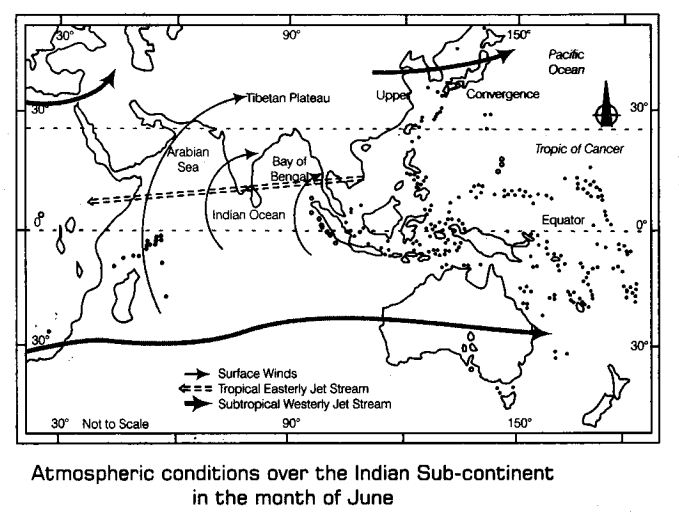
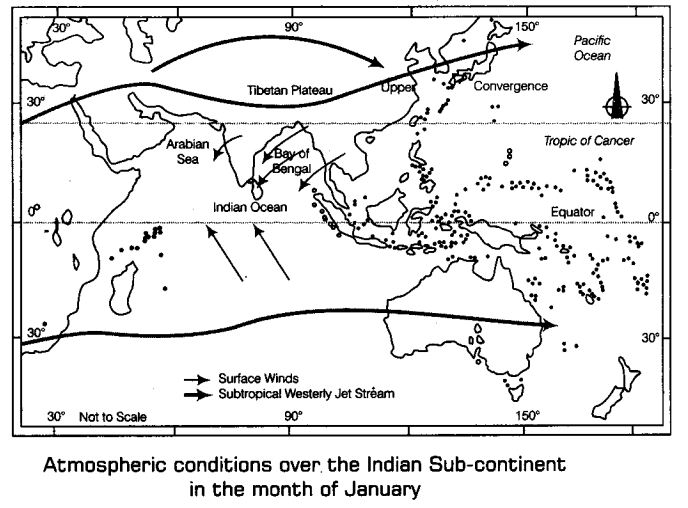
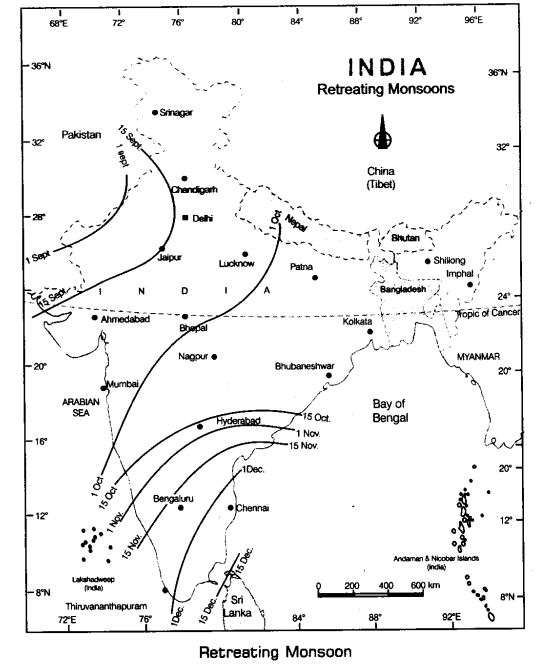
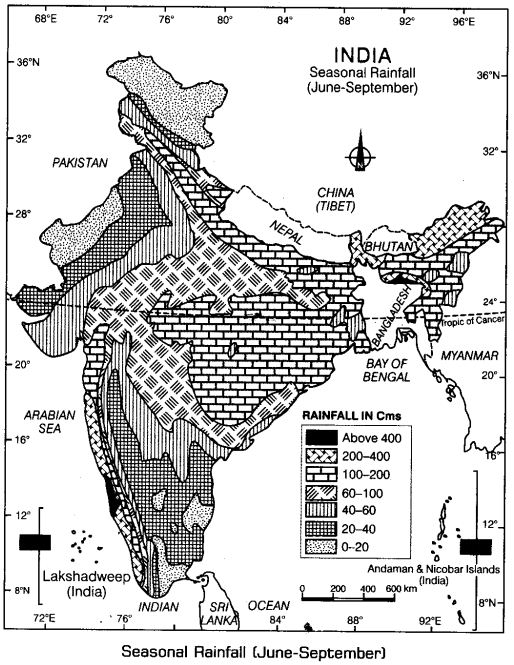
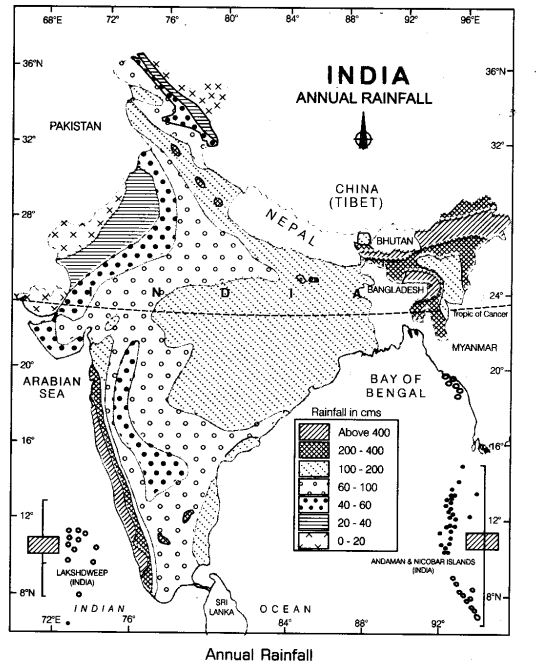
Leave a Reply